During one particular hike in Hacklebarney State Park, in Long Valley NJ, I noticed a low growing grass that spread in a dense mat along the sides of the trail.
The trail was in a shaded forested area, and so I was somewhat surprised to see the grass flourishing in such an environment.
When I knelt down and examined it, I noticed that the grass that comprised this surprising monoculture had relatively tiny elegant leaves and reminded me of small bamboo.
 |
| The elegant leaves of Microstegium vimineum |
The species, Microstegium vimineum, was just as prevalent in this park, and I was amazed at the way it formed dense mats even in relatively shaded locations.
 |
| Japanese stilt grass normally forms dense mats along trail edges |
It was also fairly easy to recognize the grass. Each leaf had a whitish strip running vertically along its dorsal surface, and a close look at the collar region showed ciliated hair growing in profusion.
 |
| Close-up of leaves and stem |
It was accidentally introduced into the USA in packing material from East Asia in the early 1900s, and it has now spread throughout the entire Eastern part of the country.
 |
| Around a tree |
 |
| Habit of Japanese Stilt Grass (Microstegium vimineum) |
 |
| Carpet along sides at Hartshorne Woods Park, NJ |
REFERENCES
Leicht, Stacey A.; Silander, John A., Jr.; Greenwood, Kate. 2005. Assessing the competitive ability of Japanese stilt grass, Microstegium vimineum. (Trin.) A. Camus. Journal of the Torrey Botanical Society. 132(4): 573-580.
Marshall JM, Buckley DS, Franklin JA (2009) Competitive interaction between Microstegium vimineum and first-year seedlings of three central hardwoods. The Journal of the Torrey Botanical Society 136: 342–349.
Morrison, J.A., Lubchansky, H.A., Mauck, K.E., McCartney, K., and B. Dunn. 2007. Ecological comparison of two co-invasive species in eastern deciduous forests: Alliaria petiolata and Microstegium vimineum. Journal of the Torrey Botanical Society 134(1):1-17.
Rauschert ESJ; Mortensen DA; Bjørnstad ON; Nord AN; Peskin N, 2010. Slow spread of the aggressive invader, Microstegium vimineum (Japanese stiltgrass). Biological Invasions, 12(3):563-579.

No comments:
Post a Comment